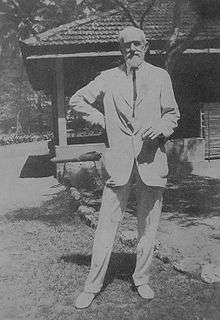Thomas Reid Davys Bell
Thomas Reid Davys Bell (2 May 1863 – 24 June 1948), born in Bandon, Cork, was a lepidopterist, naturalist and forest officer in India.

Thomas was the youngest in a family of twelve. His early education was in Dresden.[1] He tried to get into the Indian Civil Services but failed. He later wrote entrance exams to Sandhurst and Woolwich, passed but decided not to join the army. He passed the entrance for the Indian Woods and Forest Services and joined the services at Dharwad in 1884, as a Deputy Forest Officer. Here he was in touch with Edward Hamilton Aitken who was in the salt and excise department and James Davidson, collector of the district and along with these keen naturalists he began to study the Lepidoptera.[2][3][4] He also made collections of beetles which he passed on to H. E. Andrewes at the British Museum. He was in Sind between 1905 and 1906 but returned to Belgaum. Davidson had moved back to Edinburgh and he moved to live at Karwar, North Kanara District, Bombay, India. A series on the common butterflies of India was started in the Journal of the Bombay Natural History Society by L.C.H. Young,[5] but discontinued due to his ill-health. Walter Samuel Millard contacted Bell and suggested that he complete the series and Bell reluctantly took up this task.[6] He reared many lepidoptera specimens from larvae collected in the field and published on a variety of topics including a volume (1937) on the Sphingidae in The Fauna of British India, Including Ceylon and Burma in collaboration with Major F. B. Scott (who was in Assam). In 1911 he was made CIE. He became a Chief Conservator of Forests, Bombay Presidency in 1913, a position he held until his retirement in 1920. He worked on the grasses of the North Kanara region with L. J. Sedgwick, the collection now at St. Xavier's College in Bombay. Sedgwick and Bell founded the Journal of Indian Botany with P.F. Fyson as editor.[7] Later he also took an interest in the orchids and his sister made illustrations of them. He joined a timber business at Sawanthwadi along with a partner who left him with significant financial losses. In 1930 he gave his entire collection of insects to the British Museum. It had 3000 specimens of butterflies, 12000 moths, 1900 Coleoptera, 1720 Hymenoptera and 20 Orthoptera.[1] Several insect species have been described from his collections and named after Bell including:
- Acmaeodera belli Kerremans, 1893
- Ambulyx belli (Jordan, 1923)
- Idgia belli Gorham, 1895
Bell was unmarried and his sister Eva stayed with him for many years until her death in 1941.[1]
References
- Rao, BR Subba (1998) History of Entomology in India. Institution of Agricultural Technologists, Bangalore.
- Davidson, J.; Bell, T R; Aitken, E H (1898). Butterfly Life in the Tropics of India. Psyche. Volume 8. Cambridge Entomological Club. pp. 177–179.
- Davidson, J.; Bell, T R; Aitken, E H (1897). The butterflies of the North Canara District of the Bombay Presidency. IV. The Journal of the Bombay Natural History Society. Vol. 11. Mumbai: Bombay Natural History Society. pp. 22–63.
- Davidson, J.; Bell, T R; Aitken, E H (1896). The butterflies of the North Canara District of the Bombay Presidency. I, II, III. The Journal of the Bombay Natural History Society. Vol. 10. Mumbai: Bombay Natural History Society. pp. 237–259, 372–393, 568–584.
- Young, L. C. H. (1906–1907). The Common Butterflies of the Plains of India. The Journal of the Bombay Natural History Society. Vol. 16-17. Mumbai: Bombay Natural History Society. pp. 570–580.CS1 maint: date format (link) Vol. 17: 418-424, 921-927.
- Bell, Thomas Reid Davys (1909–1927). The Common Butterflies of the Plains of India (Including Those Met with in the Hill Stations of the Bombay Presidency). The Journal of the Bombay Natural History Society. Vol. 19-31. Mumbai: Bombay Natural History Society.CS1 maint: date format (link) Vol. 19: 16-58, 438-474, 635-682, 846-879, Vol. 20: 279-330, 1115-1136, Vol. 21: 517-544, 740-766, 1131-1157, Vol. 22: 92-100, 320-344, 517-531, Vol. 23: 73-103, 481-497, Vol. 24: 656-672, Vol. 25: 430-453, 636-664, Vol. 26: 98-140,438-487, 750-769, 941-954, Vol. 27: 26-32, 211-227, 431-447, 778-793, Vol: 29: 429-455, 703-717, 921-946, Vol. 30: 132-150, 285-305, 561-586, 822-837, Vol. 31: 323-351, 655-686, 951-974.
- Fyson, P.F. (1919). "Editorial". The Journal of Indian Botany. 1 (1): 1–2.